MESA VERDE (Day 16 - part 5)

Scene 2: The Basketmaker Period - 1,600 years ago
Hunter-gathers moved into the Four Corners area from about 1 AD - 500. Although there's no specific evidence of them here in Mesa Verde, they would have used the plentiful alcoves for shelter. They grew corn and squash in small fields and wove fine baskets of all shapes, sizes and purposes (pottery had not yet been developed). Clothing was made from animal skins and sandals were woven from yucca fibers.
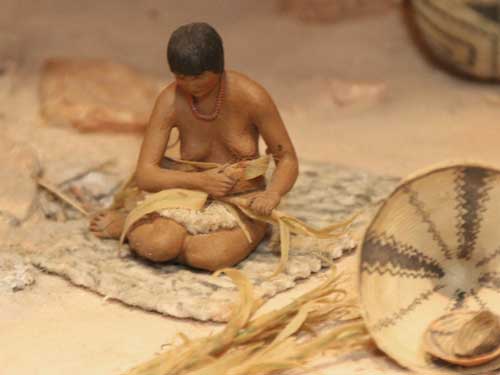
Preparing corn

Grinding corn

Constructing simple pits

Making spears

Drying meat (look at the head in the background to guess what kind of meat!) Note how twigs serve as logs.

Scene 3: The Modified Basketmaker Period - 1,300 years ago
Between 550 and 750, people began living in Mesa Verde. This is the Step House located on Wetherill Mesa. They built pithouses and were much more dependent on agriculture. They learned how to make pottery; the bow and arrow replaced the atlatl; and they domesticated dogs and turkeys. They also added beans to their staple crops of corn and squash.
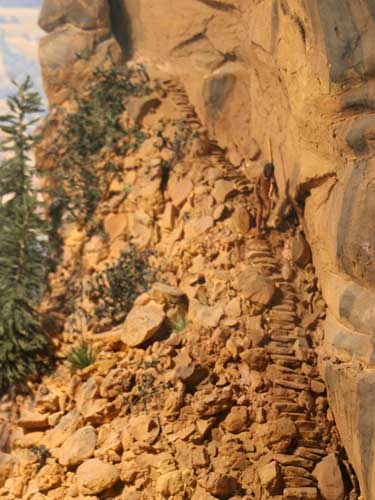
The step way down into the alcove
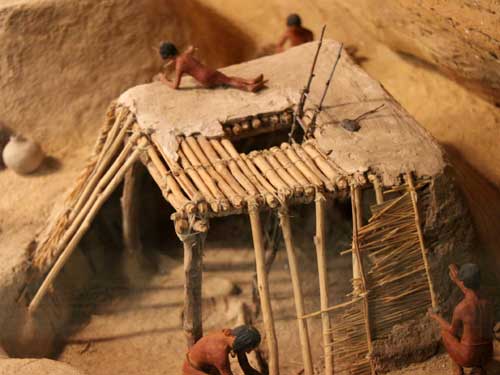
Making a pithouse

Preparing some food. Note the water flowing from the pot!

Fire was created by the use of fiber optics, a relatively new technique at the time. In 2005, modern fiber optics were installed.

Scene 4: The Developmental Pueblo Period - 1,200 years ago
The pueblo developed from 750 to 1100. Pottery and farming improved with techniques such as terraces and small dams, and trade became significant. This village was built around 850, when architecture was still experimental. Individual homes disappeared as 'row homes' replaced them. Cotton was also introduced and textiles could be woven on a loom.


Building a central community house
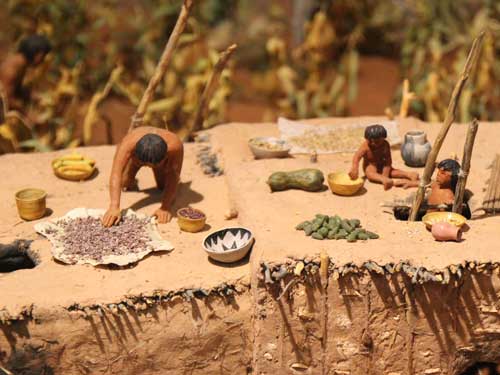
Drying beans and vegetables in the sun

Talking and laughing while working

Lunchtime!

MOM!! A turkey is trying to take my corn!

Returning from the fields with a giant squash

A bighorn sheep is the result of a successful hunt.


Scene 5: The Great or Classic Pueblo Period - 800 years ago
1100 to 1300 saw the height of development in this area. Cliff dwellings appeared, such as the Spruce Tree House pictured here in an autumn of the late 1200's. Farming techniques continued to improve and food could be stored for poor-yield years.

Building a kiva

Working hard


Lost in thought. Note his fine sandals.

Intricate designs and patterns on the pottery

Another fiber-optic fire crackles. Note the black smoke stains that mark the wall behind it.

Catching the movie

More museum exhibits

How a hole in the ground can either become a pithouse or a kiva
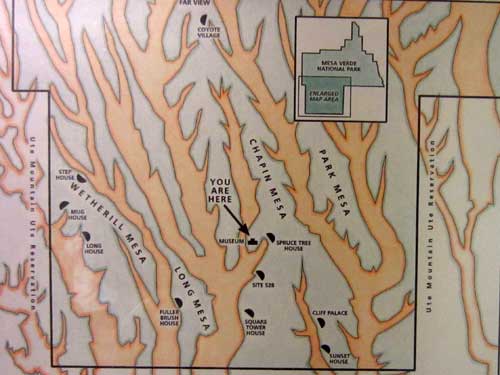



We then began the 20-mile drive back along the mesa top, stopping briefly at Far View.

About 150 wild horses live in the park. They have been here since before the park was a park. They also make their way from the neighboring Ute Mountain Ute Tribal Park. Because water is so scarce on the mesa top, the horses hover around tourist facilities, damaging water lines and ice machines while attempting to drink. They tear up wires, trample archaeological sites and break down fences meant to keep them out. They also get hit by cars. While pretty to look at, they are considered a pest up here. Unfortunately the park doesn't have the manpower or the money to manage them, either to remove them or establish them as a tourist attraction.
The Far View Community was one of the most densely populated areas. In the mid-1100's, there may have been at least 35 villages and surrounding farms within a half-square-mile area.

The Far View House, built around 1000, was the largest building in the community and most likely the center of town. It had 40 rooms on the ground floor ad about 30 rooms on the second story.

The layout

What it may have looked like

Normally this large hole, known as a kiva, would have been covered with a roof, creating a sort of courtyard above. The space below would have been used for ceremonial purposes. Kiva means 'room underneath.'
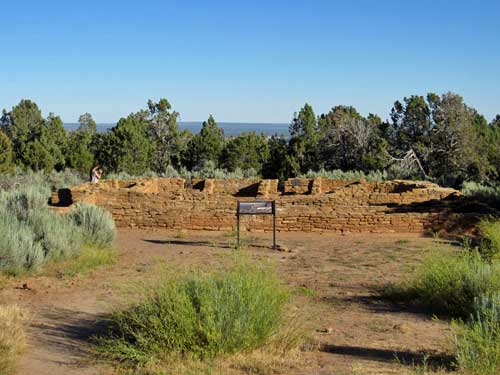
The neighboring Pipe Shrine House with about 20 rooms
As the sun began to set, we made our way back down off the mesa.

Driving alongside one of the many deep canyons

A twisty road down

Our road is visible on the upper right as well as the lower left.

Overlooking the Mancos Valley to the La Plata Mountains, a subrange of the San Juan Mountains


We arrived in Durango and booked into our motel. Unfortunately our reservation had been mistakenly switched from one room for two nights to two rooms for one night. But fortunately there was enough spare rooms to make everything work out. We had a late dinner at Denny's and returned to the motel around 9:30 pm.


return • continue

